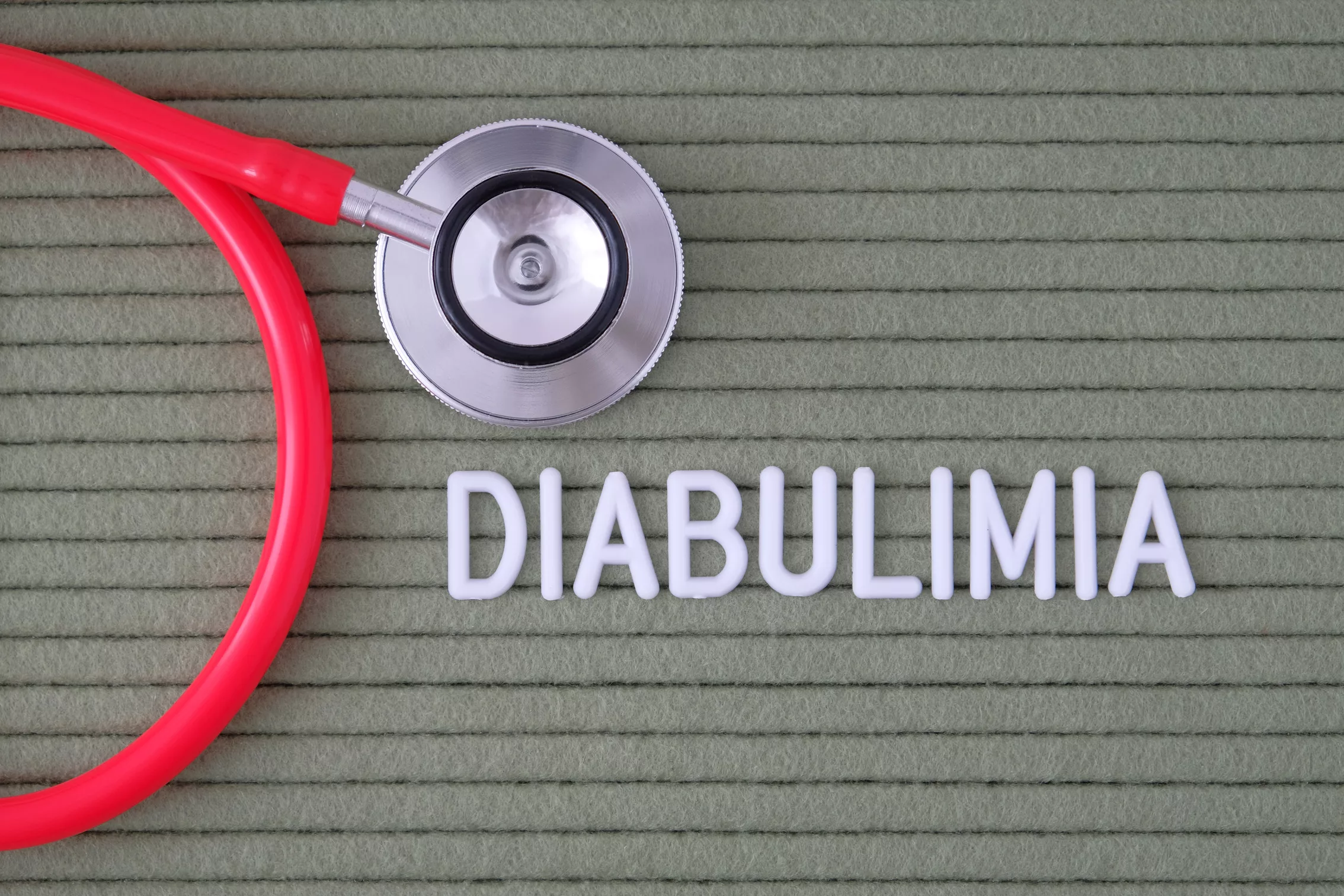What is Diabulimia?
Diabulimia is a dangerous eating disorder that affects people with type 1 diabetes who intentionally skip or reduce insulin to lose weight. Though not officially categorized in the DSM‑5 as a distinct eating disorder, diabulimia is recognized by healthcare professionals as an especially dangerous intersection of a chronic medical condition and disordered eating.1Allan, J., & Nash, J. (2014). Diabetes and eating disorders: Insulin omission and the DSM‑5. Diabetes on the Net.
What Is Type 1 Diabetes?
Type 1 diabetes is an autoimmune disease in which the body’s immune system mistakenly destroys insulin-producing cells in the pancreas. As a result, the body cannot regulate blood glucose levels without insulin injections or an insulin pump.
Insulin helps glucose move from the bloodstream into cells, where it becomes energy. Without sufficient insulin, blood sugar rises, leading to acute issues like ketoacidosis and chronic problems, such as nerve damage, vision loss, and heart disease.
One side effect of insulin therapy is weight gain. In a world where thinness is often idealized, some people, especially young women, may develop body image issues and start skipping insulin to avoid gaining weight. This is where Diabulimia begins.2Coleman, S. E., & Caswell, N. (2020). Diabetes and eating disorders: an exploration of ‘Diabulimia’. BMC psychology, 8(1), 1-7
Why Some People Skip Insulin?
Before diagnosis, many people with type 1 diabetes experience unintentional weight loss due to insulin deficiency. Once insulin treatment begins, the weight tends to return quickly.
This cycle can lead to frustration and body dissatisfaction. Skipping or reducing insulin becomes an easy but harmful way to control weight.
Without insulin, glucose builds up in the blood, and the body starts breaking down protein and fat stores. Calories are lost through urine (glycosuria), resulting in rapid but potentially dangerous weight loss.
This manipulation of insulin can severely damage the body, leading not only to DKA but also long-term damage to the eyes, kidneys, heart, and nerves.

Cause of Diabulimia
Diabulimia is caused by intentional insulin omission in people with type 1 diabetes in order to lose weight.
Type 1 diabetes requires lifelong insulin therapy. When insulin is skipped, glucose isn’t used by the body and is instead excreted in urine. This can produce quick weight loss, which some individuals begin to rely on, especially if they are dealing with poor body image, social pressure, or underlying mental health issues.
Signs & Symptoms of Diabulimia
Early warning signs may include:
- Repeated hospitalizations for diabetic ketoacidosis (DKA)
- Elevated HbA1c values despite insulin use
- Weight loss without explanation
- Avoiding meals or not taking insulin at mealtimes
- Increased interest in body image or excessive exercise
- Missing medical appointments or erratic diabetes management
- Signs of depression, low mood, or poor sleep
Other physical symptoms:
- Hair thinning or hair loss
- Dizziness
- Headaches or abdominal pain
- Amenorrhea (loss of periods) in pubescent females
- Fatigue, weakness, fruity-scented breath (from DKA)
Behavioral signs may include:
- Eating alone or hiding eating habits
- Obsession with food labels and calorie counting
- Denial of illness or defensiveness about insulin use
- Poor school or work attendance
- Preoccupation with weight or appearance
Mental health professionals, diabetes educators, or clinicians may be the first to identify these red flags.
The Immediate & Long-Term Dangers of Diabulimia
Skipping insulin may lead to short-term weight loss, but the long-term effects are serious and often fatal. Without enough insulin, the body can’t use glucose for energy. Instead, it starts breaking down fat, leading to the build-up of ketones, which can result in diabetic ketoacidosis (DKA), a medical emergency.3Polonsky, W. H., et al. (1994). Insulin omission: A weight-loss strategy among women with IDDM. Diabetes Care, 17(7), 673–679.
Over time, this behavior causes severe complications like nerve damage, organ failure, vision loss, and heart disease. Even one episode of DKA can be life-threatening.4 Torjesen, I. (2019). Diabulimia: the world’s most dangerous eating disorder. Over time, insulin omission can lead to complications such as:
- Neuropathy (nerve damage)
- Retinopathy (vision loss)
- Nephropathy (kidney damage)
- Cardiovascular disease
- Infertility and menstrual irregularities in women5Torjesen, I. (2019). Diabulimia: the world’s most dangerous eating disorder.
Diagnosing Diabulimia
Diagnosing diabulimia can be particularly challenging because it involves both medical and psychological components. It is not formally recognized as a standalone diagnosis in the Diagnostic and Statistical Manual of Mental Disorders (DSM-5), but it is widely acknowledged as a dangerous combination of type 1 diabetes and an eating disorder, usually bulimia nervosa or anorexia nervosa, with insulin restriction.
People with diabulimia often hide their behaviors, especially insulin restriction, which makes it harder to identify. That’s why doctors and diabetes care teams need to look at both physical signs and emotional or behavioral clues when diagnosing this condition.6Ruth-Sahd, L. A., Schneider, M., & Haagen, B. (2009). Diabulimia: What it is and how to recognize it in critical care. Dimensions of Critical Care Nursing, 28(4), 147–153. https://doi.org/10.1097/DCC.0b013e3181a55679
Tools & Questionnaires:
Doctors and mental health professionals may use special questionnaires to help spot signs of diabulimia:
- Diabetes Eating Problem Survey-Revised (DEPS-R): This tool was made especially for people with type 1 diabetes. It asks questions about insulin use, food habits, and feelings around eating and body image. Studies show 20–30% of young women with T1D report insulin restriction at least once, and 8–30% score high on DEPS‑R.7Allure. (2019, February 27). Diabulimia is the lesser‑known eating disorder that affects diabetics. Allure.
- Eating Attitudes Test (EAT-26): This is a general test for detecting eating disorders. It helps spot unhealthy attitudes about food, weight, and dieting.8Volkening, L. K., et al. (2010). Brief screening tool for disordered eating in diabetes. Diabetes Care, 33(3), 495–500.
- SCOFF Questionnaire: A short test with just five questions adapted to ask about insulin omission.9American Diabetes Association. (2014). Mental health handbook. ADA.
These tools aren’t enough on their own to confirm a diagnosis, but they help doctors decide if more support or evaluation is needed.10Markowitz, J. T., Butler, D. A., Volkening, L. K., Antisdel, J. E., Anderson, B. J., & Laffel, L. M. B. (2010). Brief screening tool for disordered eating in diabetes: Internal consistency and external validity in a contemporary sample of pediatric patients with type 1 diabetes. Diabetes Care, 33(3), 495–500. https://doi.org/10.2337/dc09-1890
Signs Doctors Look For:
Aside from questionnaires, there are some warning signs that might point to diabulimia:
- Very high blood sugar levels (HbA1c) over a long time, even when someone says they’re using insulin
- Frequent episodes of diabetic ketoacidosis (DKA)—a dangerous complication from not taking enough insulin
- Unexplained weight loss
- Skipping insulin doses without a medical reason
- Feeling very stressed or anxious about weight gain or insulin use
- Hospital visits for diabetes complications that keep happening
Mental Health Evaluation:
Since diabulimia is tied closely to mental health, a psychologist or therapist often becomes part of the care team. They help explore emotional challenges like body image issues, anxiety, or depression, which are often linked to disordered eating.
Treating Diabulimia
Recovery starts with recognizing the problem, not just the medical side, but the emotional one too. Treatment usually involves a team approach:
- Medical care to stabilize blood sugar and manage complications. Track HbA1c, frequent low-HR (hypo/hyperglycemia), DKA markers (like ketones), and hydration status.
- Mental health therapy, such as cognitive-behavioral therapy (CBT), to address body image and control issues
- Nutrition education with a dietitian familiar with diabetes
- Family involvement, especially in younger patients
- Prevent relapses by Ongoing therapy, peer support groups, and education programs that help maintain healthy behaviors and emotional resilience.
There’s no quick fix, but with time and the right support, people do recover. The goal isn’t just better blood sugar; it’s healing the relationship with food, body, and diabetes.
Eating Disorders and Diabulimia
Diabulimia often coexists with other disordered eating behaviors. Many individuals who restrict insulin also engage in habits like food restriction, binge eating, vomiting, over-exercising, or using laxatives. These behaviors may be present with or without ongoing insulin misuse.
Factors that increase the risk of developing these behaviors include a high body mass index (BMI), dissatisfaction with body shape, and the psychological impact of managing diabetes. Teenagers and young adults are especially vulnerable. The rapid weight gain that can occur after beginning insulin therapy during adolescence often intensifies concerns about body image.
Feeling overwhelmed by the constant attention required for diabetes management, measuring carbohydrates, calculating doses, and checking blood sugar can also push some people toward disordered behaviors as a way to reclaim a sense of control. Unfortunately, this coping strategy can lead to long-term physical and emotional damage.
Conclusion
Diabulimia lies at the intersection of Type 1 diabetes and serious eating disorders. It hurts physically, through severe complications like DKA, and mentally, by preying on vulnerable emotions.
Diagnosis depends on screening tools, spotted behaviors, trusted conversations, and psychological assessment. Early detection can be life-saving.
By blending healthcare, structured education, and mental health support, people with diabetes can learn to value both their health and body image. Awareness, empathy, and timely response can turn a deadly risk into a managed condition.
Refrences
- 1Allan, J., & Nash, J. (2014). Diabetes and eating disorders: Insulin omission and the DSM‑5. Diabetes on the Net.
- 2Coleman, S. E., & Caswell, N. (2020). Diabetes and eating disorders: an exploration of ‘Diabulimia’. BMC psychology, 8(1), 1-7
- 3Polonsky, W. H., et al. (1994). Insulin omission: A weight-loss strategy among women with IDDM. Diabetes Care, 17(7), 673–679.
- 4Torjesen, I. (2019). Diabulimia: the world’s most dangerous eating disorder.
- 5Torjesen, I. (2019). Diabulimia: the world’s most dangerous eating disorder.
- 6Ruth-Sahd, L. A., Schneider, M., & Haagen, B. (2009). Diabulimia: What it is and how to recognize it in critical care. Dimensions of Critical Care Nursing, 28(4), 147–153. https://doi.org/10.1097/DCC.0b013e3181a55679
- 7Allure. (2019, February 27). Diabulimia is the lesser‑known eating disorder that affects diabetics. Allure.
- 8Volkening, L. K., et al. (2010). Brief screening tool for disordered eating in diabetes. Diabetes Care, 33(3), 495–500.
- 9American Diabetes Association. (2014). Mental health handbook. ADA.
- 10Markowitz, J. T., Butler, D. A., Volkening, L. K., Antisdel, J. E., Anderson, B. J., & Laffel, L. M. B. (2010). Brief screening tool for disordered eating in diabetes: Internal consistency and external validity in a contemporary sample of pediatric patients with type 1 diabetes. Diabetes Care, 33(3), 495–500. https://doi.org/10.2337/dc09-1890






